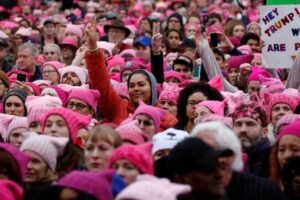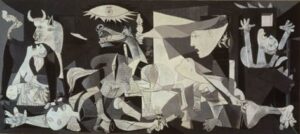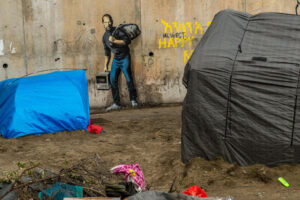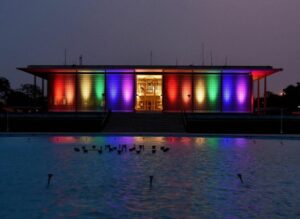Protest Art and the Art of Protesting

Throughout history, the arts have played a key role in protests. This has happened whether works of art were made for the purpose of serving protests or not: virtually anything can be utilised to serve a cause. Protest art is nothing new: during WWI the Dada movement protested against the violence of war, whilst Picasso’s Guernica drew attention to the bombing of the town during the Spanish Civil War. Protests themselves increasingly have an artistic element. This helps them gain attention from the press, public and politicians. It provides them with a shock factor without resorting to violence. Graphic designer Deva Pardue asserts that to act as a successful call to arms, protest art must be something “immediate, brazen … something that can be re-created and shared.” The inclusion of artistic elements in protests paints them as planned, thought through objections to the stances of governments and organisations.

Most protest art focuses around the depiction of a single image, figure or object in which the sentiments of many can be encapsulated. Such depictions can be broadly divided into the negative “other,” such as the image of a disliked political figure, or the positive “self,” such as symbols used to self-identify with a group, like pussyhats.
To many, the most visual element of Trump’s two visits to the UK have been the blimp portraying Trump as a screaming baby. Trump has, in many ways, been the gift to the protest artist because he’s a ready-made caricature of himself; even the robot of him tweeting from a golden toilet wasn’t too far from the truth, long tie and all (if anything, the robot wasn’t orange enough). The portrayal of other leaders has had to be more imaginative, from the famed 1831 caricature of Louis Philippe turning into a pear, to Steve Bell’s various interpretations of David Cameron. Beyond party politics, depictions of famous people can be used to comment on wider issues in society, for example Banksy’s mural of Steve Jobs outside the Calais migrant camp: “we’re often led to believe migration is a drain on the country’s resources but Steve Jobs was the son of a Syrian migrant.”

In stark opposition to Trump’s orange, pink pussyhats have become a central symbol of those who stand in opposition to him. The Pussyhat Project was founded by Jayna Zweiman and Krista Suh ahead of the 2017 Women’s March in order to take symbols often used against women, and use them as a powerful indictor of solidarity and strength. The act of women coordinating across the country to create the hats, and even songs to perform at the march, show the power of an image in unify disperse communities with a single goal. The pussyhat is democratically owned, much like the peace symbol and raised fist before it. Similarities can be drawn with The Opioid Spoon Project, which has been making news for placing a statue of the drug paraphernalia outside pharmaceutical companies in the US in response to the national opioid crisis and the industry’s role in enabling it. The growing crisis has been in the news for years, but with growing compassion fatigue, or just a genuine lack of compassion, this group of campaigners have taken a new route to get noticed.

Art has also been used to decorate symbols of oppression, notable examples being the Belfast peace lines and the Berlin wall, both of which have become tourist destinations because of their protest art. This year, US embassies across the world defied the ban on flying the pride flag in a variety of ways, with the embassy in India taking the cake for doing it the best by lighting itself up with the pride colours (it first did so in 2016 to show solidarity with the victims of the Orlando shooting).
Protest art is not only one of the best ways to raise awareness of a cause and mobilise large groups of people, it is also cost effective and open to everyone. The interaction between protests and art is only set to grow as both the public and artists themselves become more aware of and involved in issues such as climate change and inequality.
Josephine Kemp
josephine@trippassociates.co.uk
Martin Tripp Associates is a London-based executive search consultancy. While we are best-known for our work across the media, information, technology, communications and entertainment sectors, we have also worked with some of the world’s biggest brands on challenging senior positions. Feel free to contact us to discuss any of the issues raised in this blog.